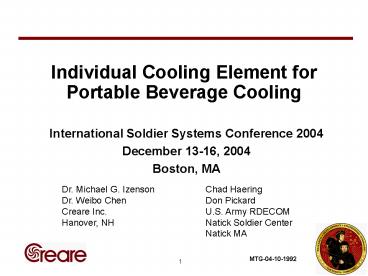Individual Cooling Element for Portable Beverage Cooling - PowerPoint PPT Presentation
1 / 13
Title: Individual Cooling Element for Portable Beverage Cooling
1
Individual Cooling Element forPortable Beverage
Cooling
- International Soldier Systems Conference 2004
- December 13-16, 2004
- Boston, MA
Dr. Michael G. IzensonDr. Weibo ChenCreare
Inc. Hanover, NH
Chad HaeringDon PickardU.S. Army RDECOM Natick
Soldier Center Natick MA
2
Summary
- Encourage adequate hydration
- Technical specifications for beverage cooling
- Regenerable absorption refrigeration approach
- Technology demonstrations
- Work under way
Focus on Equipment for Individual Soldiers (Photo
from CBS News)
3
Phase I Technical Objectives
- Goal Safe and effective operation in hot
environments - Approach Promote adequate hydration using ICEs
to cool drinking water - Technique Cooling by LiCl/water absorption
4
Requirements
- Encourage adequate hydrationin hot climates
- 17 fl oz (0.5 L)/hr for temperature lt 100F
- 34 fl oz (1 L)/hr for temperature gt 100F
- Very challenging weight/heat transfer
requirements - 32 fl oz water (0.95 L) starting at 110F
- Cooling spec 20F in 10 min
- Refrigeration requirement 74 W (253 Btu/hr)
and 12 W-hr (41 Btu) - Maximum weight of hardware 4 oz (113 g)
- Calls for innovative cooler design
- No electric power
- Extremely lightweight
- Inexpensive
Data from Army WPSM Program WBGT Wet Bulb
Globe Temperature
5
Cooling by Absorption
6
Thermodynamics
- LiCl solution has strong affinity for water
- Vapor pressure over LiCl solution is much less
than over pure water - The higher the LiCl concentration, the lower the
vapor pressure - Typical equilibrium conditions
- 90 LiCl _at_ 215F with H2O _at_ 70F
- 50 LiCl _at_ 145F with H2O _at_ 70F
- Water vapor will flow from lower temperature
water to higher temperature LiCl solution - Cooling by evaporation
7
Proof of Feasibility
- Can the ICE provide enough cooling?
- Subscale laboratory tests of key components
- Heat sink
- Integrated system
- Fabrication from lightweight, inexpensive
materials - Can the system be easily regenerated?
- Demonstrated by laboratory tests
- Will the system be lightweight?
- Demonstrated use of lightweight, inexpensive
materials - Phase I test data show size of components
- Estimated weight based on the lightweight
materials
8
Evaporator/Absorber Performance
- ICE activated _at_t ? 13 min
- Absorber DT ? 110F - 90F 20F 11C
- Heat transfer to absorber
- Heat transfer from evaporator 50 W
9
Heat Sink Testing
- Heat sink needed for heat rejection from
refrigeration process - Water flows through the heat sink
- Feasibility testing
- Heat sink tested vertically
- One-sided test
- Heat sink provided 160 W (543 Btu/hr) of cooling
at 90F (32C)
Drop in Water Temperature Implies 160 W (543
Btu/hr) of Cooling
10
Regeneration Demonstrations
- Demonstrated regeneration using absorber tubes
- Began with a tube charged with dilute(? 50)
LiCl/water solution - Heated to series of increasing temperatures at p
15 Torr - Repeated six times
- No degradation in refrigeration performance
- Regeneration performance matches thermodynamic
models - Extrapolations of LiCl/water equilibrium data
- Predicts complete regeneration at T 120C (250F)
11
LiCl Leak Detection
- QuanTAB chloride titrators manufactured by Hach
- Tested sensitivity in LiCl/water solutions with
specified concentrations - Sensitive down to 1 ppm molar concentration
- (Test H _at_ 1ppm not shown in photo)
- Titrators in drinking tube would change color to
indicate presence of LiCl
Safety Features
12
Phase II Objectives
- High cooling power and capacity
- Light weight and compact (160 g, 10 in. long x 1
in. diameter) - Safe (LiCl contained, leaks detected at very low
concentration) - Reusable
- Rugged and easy to use
- Low cost
- Scalable (2L bladders in future hydration system)
13
Conclusions
- Proof-of-concept tests have shown the feasibility
of the absorption ICE concept - Key processes demonstrated
- Critical materials identified and tested
- Analysis/design models have been verified
- Scale-up of these data show that the Phase II ICE
can meet thermal specs at 160 g - Phase II will produce optimized, field-tested
prototypes































